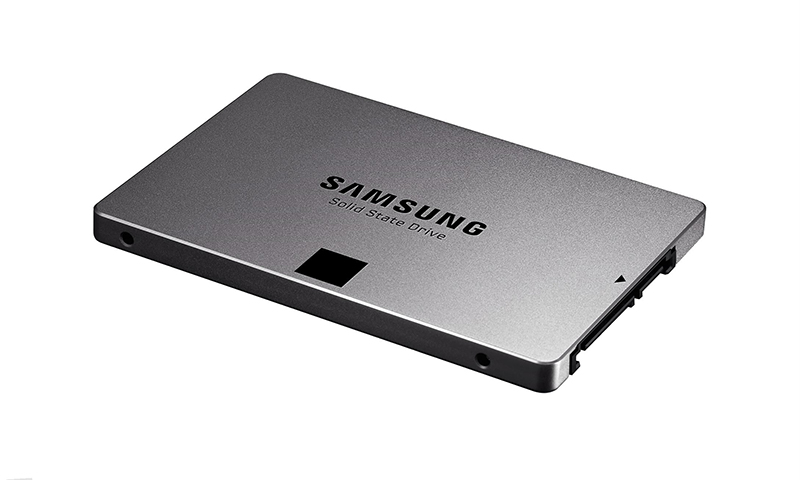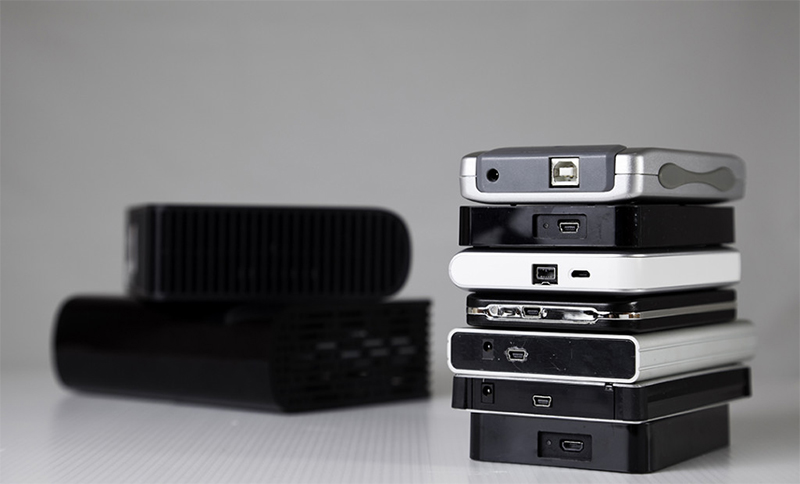An external hard drive is a megaphone attached via a standard USB port. Yes, overall, but the volume of its memory easily reconciles with this shortcoming. Roomy and productive removable screw will unload the main hard, speeding up his work, and at the same time safely keep your personal files - even the largest of them.

Content:
Top External Hard Drive Manufacturers
The well-known manufacturer in the world of computer devices is a good guarantee of quality, reliability and long life of any device. Of course, branded hard drives are more expensive, but often the costs justify themselves.
The best manufacturers of external hard drives that produce really good equipment and constantly improve their products are today considered companies:
- Transcend;
- Seagate;
- ADATA;
- Sony;
- Toshiba.
You can get acquainted with their most successful models in ranking best external hard drives. But even from the most widespread manufacturer, it is not worth buying the first available disk, not knowing the basic rules of its choice.
The principle of operation and the device external hard drive

External hard drives differ little from traditional screws installed inside the computer.
Here you will find the same basic elements as in a normal HDD:
1. Body (steel, plastic or rubber-plastic);
2. Airblock with a magnetic disk and a recording head on a movable "rocker";
3. Servo and spindle motor, forcing the disk to rotate, and the magnetic head to move along its surface;
4. The electronics unit is a board with a set of control chips.
The only thing that distinguishes an external HDD is the presence of a USB cable and the corresponding port for connecting to other devices. And also - a sealed case that protects precision mechanics from dust and debris that can disrupt its work.
The principle of the "autonomous" hard disk also has not changed. When an electric current is applied to the magnetic head, a recording or reading channel opens in it, and the field created by this changes (or recognizes) the position of the magnetized coating particles - like on a cassette in a conventional tape recorder.
Fundamentally differently arranged SSD-drive. There are no mechanical rotating or moving parts here - just a set of chips soldered to a common board. This is a fully electronic device to which information is recorded as a binary code.
However, it is difficult to call this record: each cell in the SSD disk is a miniature transistor with a floating gate. Its open position when energized is recognized as a logical unit, and closed as zero. At a given position, the shutter may be about 10 years old, which means it will keep the “recorded” information until its position changes.
Types of external hard drives
Mobile

As the name implies, these screws are designed for frequent carrying. They have compact dimensions (10x1x5 cm) and weight from 150 to 400 g. Despite their modest dimensions, mobile disks have a sufficiently large memory capacity of up to 1 TB, operate at a frequency of 3-6 GHz, and their performance can reach 250-600 MB / sec.
Pros:
- The small sizes and weight that does them convenient in storage and transportation;
- High performance;
- Sufficient for the average user memory size.
Minuses:
- Some models are susceptible to physical damage (they are afraid of shocks, falls, etc.).
Stationary

These can already weigh up to 2 kg, and in length and width reach the size of a laptop.The memory capacity of such devices ranges from 2-10 TB, the frequency exceeds 6 GHz. Stationary computers are connected to the computer mainly via USB ports, but they can use other types of interfaces.
Pros:
- Huge amounts of memory;
- High performance;
- Insured against possible damage;
- With some reservations allow carrying.
Minuses:
- Expensive;
- Overall and heavy;
- Requires a 220 V network connection.
HDD (magnetic)

Winchesters are quite common, and until recently, they are the only data storage devices. Now they are considered the slowest hard drives, but still lead the market due to large amounts of memory and relatively affordable price. They are almost twice cheaper than hybrids and cost 10 times less than solid state SSD in terms of gig.
The speed of rotation of the magnetic disk in such screws ranges from 5,400 to 15,000 rpm, the capacity reaches 10 TB (and in rare cases exceeds this figure).
The performance of classic hard drives is also quite decent - from 160 MB / s to several gigabytes. Alas, magnetic hard drives are very susceptible to damage: shocks and vibrations can completely destroy the high-precision mechanics hidden inside.
The size and weight of the HDD may be different - depending on whether you have purchased a mobile or stationary model. Accordingly, the weight ranges from 100 g to 1.5-2 kg.
Pros:
- A wide variety of form factors;
- Good amount of memory;
- Good performance;
- Very low cost.
Minuses:
- Susceptible to physical damage;
- Not the smartest.
SSD (solid state)

The most compact, fast and expensive types of external memory. Such devices can be compared with our usual flash drives - only very large. Since there are no rotating parts, solid-state disks are considered to be the most resistant to damage, although there is no need to specifically test them for strength.
The amount of memory in solid-state computers can vary widely - from 250 GB to 10 TB, but most of all they are valued for their speed.
SSD do not need to spend precious seconds on untwisting disks and moving heads - they are included in the work instantly. Speed up it adds and connect via USB-port, so that even the most difficult programs literally fly.
Pros:
- Compact size;
- Maximum processing speed;
- Resistant to physical damage, easy to transfer transportation;
- Sufficient memory;
- Convenient to use;
- Presented in a wide range.
Minuses:
- Very expensive;
- Do not like sudden changes in temperature.
SSHD (hybrid)

Already by letter designation it is clear that we are dealing with a magnetic hard drive, supplemented by memory cells of the hard core. Such a hybrid turned out to be truly viable, since it combines all the strengths of two types of hard drives.
Magnetic disks here rotate at a high speed of 7200 rpm, but their main purpose is to store large amounts of information (up to 4 TB). And the presence of electronic chips increases the speed of the external screw by 30% and significantly reduces its overall dimensions and weight - up to 0.5-1 kg.
Pros:
- Excellent processing speed;
- A decent amount of memory;
- Possibility of transportation;
- Compact size and relatively low weight;
- The average cost is higher than the HDD, but lower than the hard drives.
Minuses:
- Due to the presence of moving parts not sufficiently resistant to damage.
External hard drive selection options

Memory
The volume of an external hard drive is directly proportional to its cost, so the only limiting factor here is the thickness of your wallet.
As a rule, drives are taken as an addition to the screw installed in the computer in order to store movies, music, photos, as well as heavy games and programs. Accordingly, the volume of the hard drive must be at least 500 gigabytes.
Do not forget to check the device’s “size” of the clipboard, because it is your machine that will most often access it.The cache index can vary from 8 to 64 MB, and the standard rule applies here: it is better to choose more memory - the speed of the computer with an external disk depends on it.
Form factor
This is the size of the hard box. The memory size of the device indirectly depends on it, but to a greater extent - the convenience of its transportation.
Dimensions are specified in inches and only for screw thickness:
1. 1.8 ″ - the most popular hard drives, and not only because of its compact size. In this case, usually hide bright chips SSD, which for power supply enough energy received through a USB-connection. Alas, more than 500 gigs of information in these kids do not cram.
2. 2.5 ″ - are more common on the market, since HDD and hybrids are mostly represented. The memory capacity of such devices reaches 2 TB, but they still have enough USB power.
3. 3.5 ″ - giant discs. Of course, they have the largest amount of memory (up to 10 TB), but they are too bulky. Most often it is stationary hardy that require connection to the mains.
Interface
The external hard disk interface is a way to connect it to a computer, laptop or TV. USB is considered the most popular, convenient and fast: the latest version 3.0 can transfer information at speeds up to 5 GB / s.
The only interface that can compete with USB at data transfer speeds is Thunderbolt (formerly Light Peak). It can provide information exchange of up to 10 GB / s, however, it is compatible only with MacBooks. And if you work with Apple technology, it is no doubt better to buy hard with such an interface.
Rotation speed (for magnetic disks)
From this indicator directly depends on the speed of the hard, and, accordingly, the computer. And yet - your upcoming expenses:
1. Devices issuing 5400 rpm, the slowest, but also the cheapest;
2. 7200 rpm - the perfect combination of price and speed;
3. 10,000 rpm and more are very expensive and are designed to work in conjunction with powerful computers.
Availability of additional functions
1. Cooling is necessary for large stationary models. It will protect the drive from overheating, and subsequently from damage and total failure.
2. Shock properties - some manufacturers promise that the hard will not break even if it is dropped from the 3rd floor, but such models will cost more. As a rule, these are SSD-drives, in the names of which there are the words “armor”, “power”, “steel”, etc.
3. Dust and moisture protection - achieved by sealing the hard drive case. Of course, this does not mean that hard can be taken with you into the shower, but it will survive the spilled tea or coffee.
Which external hard drive to choose

1. If you need an inexpensive removable screw for expanding the main memory, it is better to purchase a small HDD up to 500 GB of 3.5 ″ form (they are more affordable). Performance should be at least 160 MB / s, spindle speed - 5400 r / min. These are the “cheapest” features, but quite suitable for a not very powerful home computer.
2. Need a more or less good disk for storing rare programs, games and personal files? An excellent option would be a hybrid SSHD. You will have enough capacity in 1 TB with your head, but you will need high performance - about 300 MB / s with a spindle speed of the magnetic part of at least 7200 per minute. This hard can be used not only as an addition to the main drive, but also to replace it.
3. If you have the money to buy the best external hard drive, then do not be stingy - take a solid-state SSD. Here, no one will hold you back in the selection of characteristics - the higher the main indicators of the disk, the more powerful and reliable it is.
How much is an external hard drive

1. Removable HDD, depending on its basic characteristics and the manufacturer, can be purchased for 2000 rubles and 50,000 rubles.
2. External SSD will cost from 5 to 170 thousand rubles.
3. Hybrid SSHD for the price will be somewhere in the middle - in the range of 3-130 thousand.
It will be interesting to friends too







